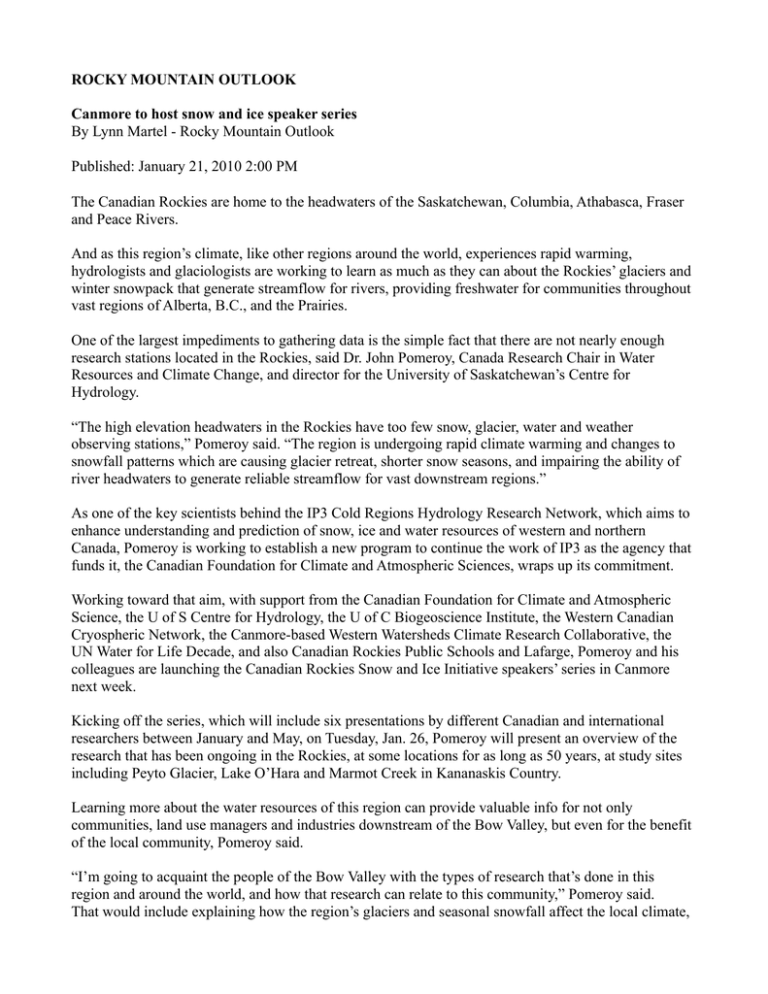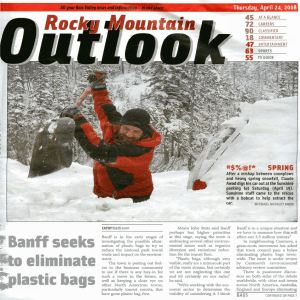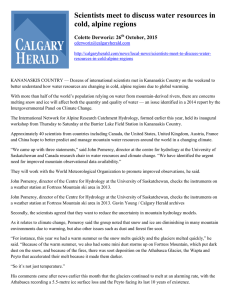ROCKY MOUNTAIN OUTLOOK Canmore to host snow and ice speaker series
advertisement

ROCKY MOUNTAIN OUTLOOK Canmore to host snow and ice speaker series By Lynn Martel - Rocky Mountain Outlook Published: January 21, 2010 2:00 PM The Canadian Rockies are home to the headwaters of the Saskatchewan, Columbia, Athabasca, Fraser and Peace Rivers. And as this region’s climate, like other regions around the world, experiences rapid warming, hydrologists and glaciologists are working to learn as much as they can about the Rockies’ glaciers and winter snowpack that generate streamflow for rivers, providing freshwater for communities throughout vast regions of Alberta, B.C., and the Prairies. One of the largest impediments to gathering data is the simple fact that there are not nearly enough research stations located in the Rockies, said Dr. John Pomeroy, Canada Research Chair in Water Resources and Climate Change, and director for the University of Saskatchewan’s Centre for Hydrology. “The high elevation headwaters in the Rockies have too few snow, glacier, water and weather observing stations,” Pomeroy said. “The region is undergoing rapid climate warming and changes to snowfall patterns which are causing glacier retreat, shorter snow seasons, and impairing the ability of river headwaters to generate reliable streamflow for vast downstream regions.” As one of the key scientists behind the IP3 Cold Regions Hydrology Research Network, which aims to enhance understanding and prediction of snow, ice and water resources of western and northern Canada, Pomeroy is working to establish a new program to continue the work of IP3 as the agency that funds it, the Canadian Foundation for Climate and Atmospheric Sciences, wraps up its commitment. Working toward that aim, with support from the Canadian Foundation for Climate and Atmospheric Science, the U of S Centre for Hydrology, the U of C Biogeoscience Institute, the Western Canadian Cryospheric Network, the Canmore-based Western Watersheds Climate Research Collaborative, the UN Water for Life Decade, and also Canadian Rockies Public Schools and Lafarge, Pomeroy and his colleagues are launching the Canadian Rockies Snow and Ice Initiative speakers’ series in Canmore next week. Kicking off the series, which will include six presentations by different Canadian and international researchers between January and May, on Tuesday, Jan. 26, Pomeroy will present an overview of the research that has been ongoing in the Rockies, at some locations for as long as 50 years, at study sites including Peyto Glacier, Lake O’Hara and Marmot Creek in Kananaskis Country. Learning more about the water resources of this region can provide valuable info for not only communities, land use managers and industries downstream of the Bow Valley, but even for the benefit of the local community, Pomeroy said. “I’m going to acquaint the people of the Bow Valley with the types of research that’s done in this region and around the world, and how that research can relate to this community,” Pomeroy said. That would include explaining how the region’s glaciers and seasonal snowfall affect the local climate, and also industries including recreation. “I am keen to develop the science and predictive modelling to the point where we can deploy it across the main runoff generation zone of Alberta - the Rockies and eastern slopes - to calculate runoff to the major rivers for current, very near future and future land use scenarios and climate conditions,” Pomeroy said. “This would be useful for water managers and assessments province-wide, and will directly assist water managers dealing with basins near and in the mountains and eastern slopes.” The long-term goal of establishing a Canmore-based research program (for which funding is currently being sought), would be to grow the scientific community to become a Canadian hub for research, similar to Davos, Switzerland. Similar to Canmore in environment protected heritage, Davos is home both to a vibrant recreational industry and to a strong science and outreach industry through the Swiss Institute for Snow and Avalanche Research and World Economic Forum. “We’d really like to see the addition of a science industry in Canmore,” Pomeroy said. “But we’re not building microchips. We’re trying to build up a knowledge industry appropriate to the mountains. This is the best place in Canada to do this.” In fact, Pomeroy is so convinced of this that he relocated his entire family to Canmore in July, taking advantage of a scheduled sabbatical to work toward getting the Canadian Rockies Snow and Ice Institute off the ground. As well, IP3’s network manager Julie Friddell and her husband David Friddell, a physicist specializing in snow computer modeling, have also relocated their whole family. Field technician May Guan and research assistant Logan Fang have also relocated to Canmore, and plans are underway for more members of the U of S Centre for Hydrology to follow. “I decided this sabbatical was a perfect opportunity to get this off the ground,” Pomeroy said. “It’s pretty much a leap of faith, but I think it’s a good one.” Pomeroy’s talk, Creating a “Canadian Davos” in the Bow Valley, takes place Tuesday, Jan. 26, at Canmore Collegiate High School Theatre, starting at 7 p.m. The free presentation will be followed by refreshments and questions from the audience directed toward Canadian Rockies Snow and Ice Initiative members on what this scientific research program can mean for Canmore and the Bow Valley.




